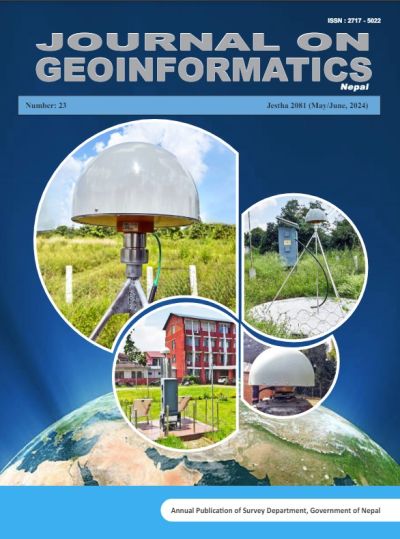Integration of GNSS, Total Station, and Grid Controls: An Analysis of Combined Effect of Elevation of Topography and Map Projection Distortion to Solve the Distance Discrepancy
DOI:
https://doi.org/10.3126/njg.v23i1.66049Keywords:
Control Survey Methods, Topography, Map Projection Distortion, Distance Discrepancy, GNSS, Total Station, Grid Controls, IntegrationAbstract
Heterogeneous measurements from various surveying methods need to be integrated to accomplish any survey project. The use of Global Navigation Satellite System (GNSS) and Total Station (TS) to establish a control framework along with utilizing existing national grid controls, for any survey project has been the standard practice. However, the successful integration of GNSS, TS, and existing grid controls could be challenging at times. Both survey professionals, and surveying stakeholders would benefit from the successful augmentation of heterogeneous measurements from GNSS, TS, and existing grid controls in order to provide a control framework for their survey project. In the past, the distance discrepancy/mismatch of GNSS-derived distance which is obtained from indirect measurements from GNSS survey and TS distance which is ground-based direct measurements, has created confusion. Herein, we have analyzed in detail, the combined effect of elevation of topography and map projection's distortion on the distance; demonstrate the magnitude of combined effect by numerical examples; tested this formulation with real-world GNSS and TS measurements. This way we proposed a solution to solve distance discrepancy/mismatch between various survey methods. The magnitude of the combined effect would be substantial with higher elevations and longer distances and could cross the threshold of specified/required accuracy. The effect would be more pronounced in mountainous regions suggesting combined effect should be properly taken into account. Taking combined effect into consideration brings the compatibility and comparability of GNSS, TS, and existing grid controls together. Thus, allowing both survey professionals and surveying stakeholders to utilize the mix of GNSS, TS, and existing grid controls to achieve required precision and accuracy in an economical, timely, and easy manner.




